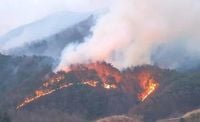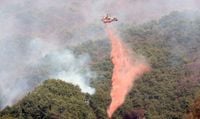A wildfire that erupted in Sancheong, Gyeongnam Province, has caused significant alarm as it approaches the boundary of the Jirisan National Park. As of March 26, 2025, authorities noted that the fire reached within 200 meters of the park's border, leading to increased evacuations and firefighting efforts across the affected areas.
The blaze began on March 21, 2025, in Sicheon-myeon, and by the afternoon of March 26, the firefighting efforts had managed to extinguish approximately 75% of the Sancheong and Hadong wildfires. However, conditions have been challenging due to a thick layer of fallen leaves that inhibited firefighting operations, according to officials from the Korea Forest Service.
Park Myung-gyu, the Administrative Vice Governor of Gyeongnam Province, reported in a briefing that the extinguishing rate had declined slightly from 80% earlier that day to 75% by noon. He stated, "As of 12 PM on March 26, the affected area has expanded to 1,702 hectares, with 64 kilometers of fire line — 16 kilometers are under control, and 48 kilometers are fully extinguished." He also emphasized the impact on local households, with 1,732 residents being evacuated to schools and community centers.
The firefight involved deploying 30 helicopters, 1,720 personnel, and 218 vehicles, with additional support requested from neighboring provinces like Jeonnam and Jeonbuk. Evacuations were executed in a swift response to ensure the safety of residents in areas like Danseong Middle School, Okjong Elementary School, and Jinseo High School, where evacuees gathered.
"We are prioritizing the safety of residents while trying to suppress the fire’s encroachment toward Jirisan National Park," stated Park during the Wednesday morning briefing. The terrain had made it difficult for aerial units to coordinate effectively, particularly with gusting winds affecting operations. As officials awaited forecasts of rain, they feared ongoing high winds could exacerbate the situation.
As reported, the fire had already resulted in 4 fatalities and 9 injuries since it began. The tragic toll included an injured firefighter on March 25 during the intense emergency efforts to contain the blaze. Tragically, the extent of the damage was clear: 64 buildings, including 16 homes, had been destroyed by the advancing flames.
Currently, the Forest Service is focused on creating “fire lines” to prevent further spread into the national park region. Workers have faced difficulties due to the deep layers of dried leaves, which often reignite whenever water is sprayed on them, allowing the flames to persist. "It’s a relentless battle against the elements," remarked a field operative engaged in combating the fire.
At noon on March 26, fire officials confirmed that the wildfire crossed the Gugoksan ridge and moved into the Jirisan area, further complicating the firefighting efforts. By all accounts, this has become a significant wildfire event for the region, compelling local and provincial authorities to deploy all available resources.
The situation highlights the precariousness of wildfire responses in hilly regions, marked by unpredictable weather patterns and the explosive nature of dry brush. With evacuations ongoing, experts have cautioned about the potential for more fatalities if the fire continues to spread unchecked.
An optimistic turn in the weather could arrive as forecasts indicate weak rain showers may hit the area on March 27, expected to last for about three hours in the afternoon. But in the meantime, the focus remains sharply on containment strategies and protecting local communities.
As fire crews continue their grueling efforts, the intertwined safety and environmental management challenges loom large. Local officials urge residents to remain vigilant and heed evacuation orders as firefighters work tirelessly to prevent further destruction.
The rapidly evolving situation serves as a stark reminder of the dangers posed by wildfires and the essential efforts of the personnel on the ground. As this story develops, updates will continue to follow, with hopes for rain that could relieve the dire conditions faced in Sancheong and surrounding regions.

![[속보] 산청 산불, 지리산 넘었다](https://thumbor.evrimagaci.org/7oHNBaoLba5r-keiduDYyROO1_U=/200x0/tpg%2Fsources%2F2645ce86-3019-42d4-989a-96399c2f7f42.jpeg)
![[속보]‘산청 산불’ 지리산 방화선 넘어…국립공원으로 200m 진입](https://thumbor.evrimagaci.org/j39sDja-t4AslzER9_pStifzGfY=/200x0/tpg%2Fsources%2F22605f71-f81f-4387-b9f7-28720567b36e.jpeg)
![‘엿새째’ 산청 산불…결국 지리산까지 번졌다 [지금뉴스]](https://thumbor.evrimagaci.org/wyjN52PhHA71PNF9XkZKRELy8LU=/200x0/tpg%2Fsources%2Fe9a11daf-946e-4a41-a828-009bb931e3b6.jpeg)




